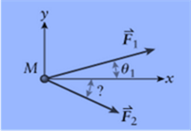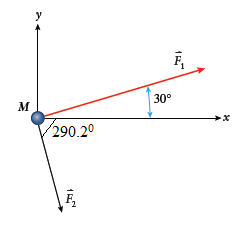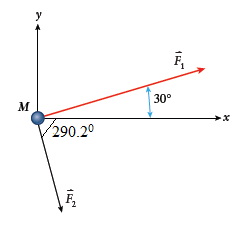
Concept explainers
(a)
The magnitude of
Answer to Problem 62QAP
The magnitude of
Explanation of Solution
Given info:

Mass,
Acceleration,
And
Formula Used:
Calculation:
Consider as two forces are attached to an object of mass M.
Let rope
We need to determine the magnitude and direction of rope
We are told that the box accelerates only in the x-direction at a rate of
We can use Newton's second law in component form in order to calculate the components and, therefore, the magnitude and direction of force
Conclusion:
The magnitude of
(b)
A careful drawing to show direction of
Answer to Problem 62QAP
The below diagram shows the direction of

Explanation of Solution
Given info:

Mass,
Acceleration,
And
Formula Used:
Calculation:
Consider as two forces are attached to an object of mass M.
Let rope
We need to determine the magnitude and direction of rope
We are told that the box accelerates only in the x-direction at a rate of
We can use Newton's second law in component form in order to calculate the components and, therefore, the magnitude and direction of force
On substituting given values we have: -
290.20
Conclusion:
Thus, we obtained the direction of

Want to see more full solutions like this?
Chapter 4 Solutions
COLLEGE PHYSICS
- X Figure 5-29 Three astronauts, propelled by jet backpacks, push and guide a 120 kg asteroid toward a processing dock, exerting the forces shown in Figure 5-29, with F1 = 32 N, F2 = 54 N, F3 = 41 N, 01 = 30°, and 03 = 60°. What is the asteroid's acceleration in unit-vector notation?arrow_forward2-13 Determine the horizontal and vertical components of each force shown in Figure P2-13. A- P= 2* P= 20 lbi 20° 50 120 P= 25 lb Figure P2-13a Figure P2-13b Flgure P2-13carrow_forwardP4-2 A crate of mass m=31.9 kg is in the bed of a pickup truck with the tailgate closed. There is negligible friction between the horizontal bed and the crate. The tailgate is vertical and contacts the back side of the crate. The truck accelerates forward on horizontal ground at a rate a=4.3 m/s2. What is the magnitude, in newtons, of the total force exerted on the crate by the truck?arrow_forward
- P3-2 Problem 2: A 71 kg man is being pulled away from a flaming building as shown in the figure. Part (a) Calculate the tension T1 on the left side of the rope, in newtons, if the man is in static equilibrium. Part (b) Calculate the tension T2 on the right side of the rope, in newtons, if the man is in static equilibrium.arrow_forwardProblem A) A 3.0 kg object has two forces acting on it. Force F = (18å + 103)N while F2 is unknown. The velocity at t = 6 seconds is v = (12å + 243)m/s. If the object was initially at rest, determine F, and its displacement at t = 6 s in unit vector notation. Assume that these are the only two forces acting on the object.arrow_forwardQUESTION 2 A block is pushed across a horizontal surface by the force shown. If the coefficient of kinetic friction between the block and the surface is 0.30, F = 20 N, e = 30°, and M = 3.0 kg, what is the magnitude of the acceleration of the block? F M O 2.3 m/s2 O 1.8 m/s2 O 5.4 m/s2 O 3.3 m/s2 O 2.8 m/s2arrow_forward
- Find the magnitude and direction of the resultant of the five concurrent forces acting on a bolt. 2-54 Fig. P2-53 The five forces shown in Fig. P2-54. y F₂ = 400 N F₁ = 80 N F3 = 150 N 22° 27° 46° Fig. P2-54 45° 18° F4 = 300 N F5 = 250 N Xarrow_forwardA particle experiences exactly two forces -> ^ -> ^ ^ F 1 = 1N i ; F2 = -1 N i + 3 N j Which is true? the magnitude of acceleration = 3m/s2 the y-component of the position is increasing the x-component of the velocity is constant or the magnitude of the net force is 5Narrow_forward3-8 Determine the magnitude and direction angle of force F, so that the particle shown in Fig. P3-8 is in equilib- um. F₁ = 500 N F₂-750 N 33% 30° 60° F3 = 1000 N Fig. P3-8 0arrow_forward
- P2-7 The diagram shows a crate of mass m=154 kg on a frictionless inclined plane that makes an angle, θ=36∘, with the horizontal. A coordinate system is provided. A force of magnitude F, parallel to and directed up the plane, is applied to the crate. The crate accelerates up the plane at 2.6 m/s2. In numeric responses, use 9.80m/s for the acceleration due to gravity. Part (b) What is the numeric value, in newtons, of the applied force, F?arrow_forwardProblem 2 A crate rests on the flatbed of a truck traveling at 15m/s on a level road. The driver applies the breaks and the truck is brought to a halt in a distance of 38m. If the deceleration of the truck is constant, what is the minimum coefficient of friction between the crate and the truck to keep the crate from falling: (a) 0.2 (b) 0.3 (c) 0.6 (d) cannot be determinedarrow_forwardItem 4 4 of 6 A pilot performs an evasive maneuver by diving vertically at 230 m/s Part A If he can withstand an acceleration of 8.0 g's without blacking out, at what altitude must he begin to pull out of the dive to avoid crashing into the sea? Express your answer to two significant figures and include the appropriate units. 31 ? Value Units Submit Request Answer Provide Feedback Next >arrow_forward
 Principles of Physics: A Calculus-Based TextPhysicsISBN:9781133104261Author:Raymond A. Serway, John W. JewettPublisher:Cengage Learning
Principles of Physics: A Calculus-Based TextPhysicsISBN:9781133104261Author:Raymond A. Serway, John W. JewettPublisher:Cengage Learning College PhysicsPhysicsISBN:9781285737027Author:Raymond A. Serway, Chris VuillePublisher:Cengage Learning
College PhysicsPhysicsISBN:9781285737027Author:Raymond A. Serway, Chris VuillePublisher:Cengage Learning Physics for Scientists and Engineers, Technology ...PhysicsISBN:9781305116399Author:Raymond A. Serway, John W. JewettPublisher:Cengage Learning
Physics for Scientists and Engineers, Technology ...PhysicsISBN:9781305116399Author:Raymond A. Serway, John W. JewettPublisher:Cengage Learning College PhysicsPhysicsISBN:9781305952300Author:Raymond A. Serway, Chris VuillePublisher:Cengage Learning
College PhysicsPhysicsISBN:9781305952300Author:Raymond A. Serway, Chris VuillePublisher:Cengage Learning Physics for Scientists and Engineers: Foundations...PhysicsISBN:9781133939146Author:Katz, Debora M.Publisher:Cengage Learning
Physics for Scientists and Engineers: Foundations...PhysicsISBN:9781133939146Author:Katz, Debora M.Publisher:Cengage Learning




